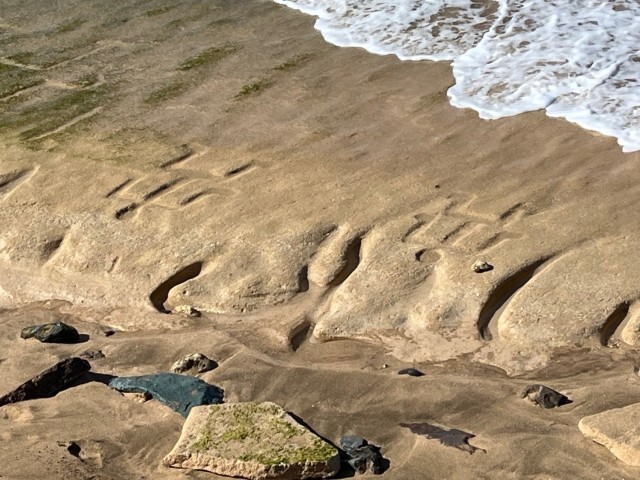WAIANAE, Hawaii — As the sun rises over the rugged Waianae coast, gentle waves lap against a stretch of sandstone at the Pililaau Army Recreation Center, revealing a story carved in stone. On the morning of July 12, 2025, as the tide receded, seasonal swells unveiled a 115-foot panel of ancient Hawaiian petroglyphs — 26 carvings of stick figures and abstract forms, etched into lithified sandstone more than 500 years ago.
For the U.S. Army Garrison Hawaii’s Cultural Resources Management Program, preserving these carvings represents a commitment to safeguarding Native Hawaiian heritage while maintaining operational readiness.
“Seasonal changes in tide and wave energy have shifted the sands along the beach and fully exposed these petroglyphs,” said Dave Crowley, cultural resources program manager. “This is the first time since 2016 that the entire panel has been visible.”
Crowley leads a team of archaeologists, historians, and cultural specialists, who manage cultural resources across more than 168,000 acres, 2,000 historic buildings, eight historic districts, three National Historic Landmarks, and over 1,800 archaeological sites across 22 installations on Oahu and the island of Hawaii.
The petroglyphs, first documented in 2016 and 2017, include 18 human-like figures—some with possible male traits, others with dynamic poses—ranging from 15 centimeters to over two meters.
“While it is difficult to pin down an exact date, these could potential be upwards of 600 years old, based on nearby sites,” said Laura Gilda, principal archaeologist. “We documented them to share with the community while keeping them safe.”
The Garrison’s Cultural Resources Management Program ensures compliance with laws like the National Historic Preservation Act and Native American Graves Protection and Repatriation Act. The team uses advanced 3D photogrammetry for virtual site access and facilitating more than 50 annual cultural visits for Native Hawaiian organizations in restricted areas.
This cultural stewardship builds vital community partnerships. Cultural awareness training helps soldiers understand and respect sacred sites during training exercises. Strong relationships with Native Hawaiian communities ensure continued access to lands essential for operations like the Joint Pacific Multinational Readiness Center.
“Stewarding these lands is vital to our mission,” said Crowley. “By protecting cultural sites like these petroglyphs, we honor Hawaii’s heritage, build stronger community ties.”
As the tides continue to shift and recover the petroglyphs, each figure— whether warrior, ceremony, or symbol—stands as a testament to the enduring connection between Hawaii's past and present.
For more information about U.S. Army Garrison Hawaii’s cultural resources and environmental stewardship programs, visit https://home.army.mil/hawaii.






Social Sharing